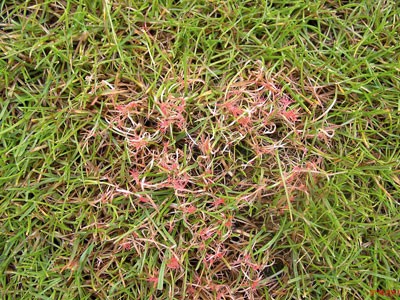Turf & Lawn Blog
Lawn Problems | Part 3 - Red Thread
The previous article on lawn problems mentioned that patches can often be caused by lawn diseases. One of the most common is the fungus red thread (Laetisaria fuciformis), which generally develops in late summer or autumn, especially when the weather is wet. Red thread usually develops on grass that is badly aerated and low in nitrogen. Even if you regularly apply nitrogen, heavy or prolonged rain may wash it away.
The patches caused by this fungus often appear reddish at first, although they will later turn to lighter brown or look bleached. The patches are usually between 7.5cm and 25cm, although they can be bigger.

If you’re still in doubt about whether you have red thread, take a closer look with a magnifying glass. You will generally see two types of fungal growth, one which is small, pink and cottony, and can look similar to the fungus causing snow mould. The second gives red thread its name: pinkish-red gelatinous ‘threads’ 1-2mm long, which form on the leaves, and can bind them together. They are often visible with the naked eye, especially in humid conditions.
The good news is that red thread doesn’t very often kill grass, as it doesn’t attack the roots. So your lawn turf will recover quickly with appropriate treatment. You should apply nitrogen to the affected area, in the form of ammonium sulphate, at 15g per square metre. Do not apply after August, as you will encourage growth which will be prone to other moulds and diseases.
If it is too late to apply nitrogen, or nitrogen was ineffective, you can try using a fungicide. The only one currently available for domestic use is trifloxystrobin (Bayer Garden Lawn Disease Control). You can use this at any time of year, unless it is very dry or the ground is frozen, but you should not use it more than twice a year.
There are lawn maintenance companies who can treat with fungicides licenced for professional use. However, the Royal Horticultural Society advises that there is strict legislation about what professional products can be used in domestic gardens, so you will need to make sure that the company is operating legitimately in applying chemicals to your lawn.
The best treatment for red thread is prevention, by applying nitrogen and improving drainage. Scarifying with a lawn rake will remove moss and dead grass, and allow more air to the roots. You can improve drainage by making holes with a garden fork or a hollow-tine aerator.
Finally, if you have had red thread, dispose of the grass cuttings from your lawn without composting, as this will help to prevent reinfection. Spores can live dormant for up to two years.
If you do need to patch your lawn you can buy turf or use seed, see our article on the pros and cons of both these options.
When you subscribe to the blog, we will send you an e-mail when there are new updates on the site so you wouldn't miss them.
